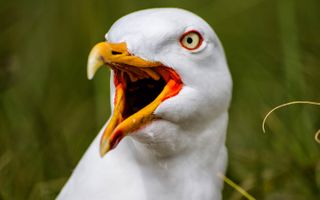Chihuahua Was Abducted by a Seagull. It Could Happen, Expert Says.

A wee chihuahua was recently snatched from his backyard in Paignton, Devon, a seaside town in the southern part of the United Kingdom.
The culprit, according to his owner, was a seagull.
While there are no photos or video documenting the attack, large gulls have been known to ambush small mammals — including pet dogs — even flying with them for short distances, an avian expert told Live Science. [Beastly Feasts: Amazing Photos of Animals and Their Prey]
But while such an attack is feasible, "they are very rare," said Viola Ross-Smith, a science communicator with the British Trust for Ornithology, who earned her doctoral degree while researching large gulls.
"Like this time, the reports usually do not come with photographic evidence and are covered quite sensationally in the media, so it's hard to know exactly what happened," Ross-Smith told Live Science in an email.
On July 21 in Devon at 12:30 p.m. local time, the gull purportedly struck quickly and without warning, the dog's owner, Becca Hill, told Devon Live. Her chihuahua — a brown-and-white 4-year-old male named Gizmo — was safe in the garden, while Hill's partner hung out the washing to dry nearby. Suddenly, a gull swooped down and scooped up the tiny pup with its beak. And just like that, Gizmo was gone. His owners could only watch helplessly as the gull carried poor Gizmo away, Devon Live reported.
"I have no idea if he was dropped or where he is now," Hill said.
Sign up for the Live Science daily newsletter now
Get the world’s most fascinating discoveries delivered straight to your inbox.

In the U.K., the gulls most commonly found in urban areas are herring gulls (Larus argentatus) and lesser black-backed gulls (Larus fuscus). Lesser black-backed gulls can measure up to 25 inches long (64 centimeters) with a wingspan of up to 59 inches (150 cm), while herring gulls measure up to 26 inches long (66 cm) with a wingspan of 58 inches (146 cm), according to the Cornell Lab of Ornithology.
Like many other types of large gulls, both species are omnivores that eat whatever they can find. The bulk of their diet is typically made up of fish, invertebrates, vegetables and discarded human food, but sometimes near-chihuahua-size mammals such as rats, moles and even small rabbits are on the menu, Ross-Smith said.
Seagulls have also been known to seek out other snacks that are perhaps even more gruesome: parasitic worms found in seal poo and baby seals' eyeballs.
Chihuahuas generally weigh no more than 6 lbs. (3 kilograms), but so-called miniature chihuahuas or teacup chihuahuas (which are not officially recognized breeds, according to the American Kennel Club) can be even lighter, so they are about the same size as other animals that are the natural prey of gulls, Ross-Smith explained. After picking up its prey, a gull may carry it a short distance, she added.
"They tend to fly up with them to the height of just a few metres and then drop them, to overcome them as part of the predation process," Ross-Smith said. "They are powerful fliers, but they don't fly far with prey items like that."
But Gizmo's abductor purportedly carried the dog "a fair way" until his owners couldn't see him anymore, Hill told The Guardian. She distributed flyers and shared his photo with local animal rescue organizations. One such agency, UAV Lost Dog & Rescue, shared a poster on Facebook, urging neighbors to check rooftops and trees for Gizmo, "sadly still missing" as of yesterday (July 22).
"It is unknown if Gizmo may have been dropped," according to the poster.
However, it's important to note that such attacks are uncommon, and gulls typically do not pose a threat to small pets or children, Ross-Smith said.
"Gulls don't just randomly attack people or other animals. They will defend their nest and chicks if a person or animal comes too close — the distance varies from nest to nest, and throughout the breeding season — but even in those cases, they usually just swoop and call," she said.
- Top 10 Species Success Stories
- Marine Marvels: Spectacular Photos of Sea Creatures
- 7 Resolutions for a Better Planet
Originally published on Live Science.

Mindy Weisberger is an editor at Scholastic and a former Live Science channel editor and senior writer. She has reported on general science, covering climate change, paleontology, biology, and space. Mindy studied film at Columbia University; prior to Live Science she produced, wrote and directed media for the American Museum of Natural History in New York City. Her videos about dinosaurs, astrophysics, biodiversity and evolution appear in museums and science centers worldwide, earning awards such as the CINE Golden Eagle and the Communicator Award of Excellence. Her writing has also appeared in Scientific American, The Washington Post and How It Works Magazine.
